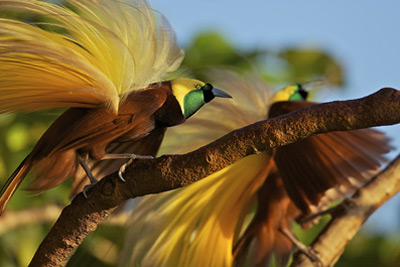Birds-of-paradise site offers videos, classroom tools

All 39 species of birds-of-paradise – some of the most extraordinary birds in the world – are flying into living rooms and classrooms as a new educational website debuts from the Cornell Lab of Ornithology.
With 35 high-definition videos as a centerpiece, the Birds-of-Paradise Project site offers full-frame footage of the birds and an exploration into the scientific principles that led the creatures to evolve. The site offers more than two hours of never-before-seen footage, images, sounds and interactive features as well as free, downloadable lesson plans.
Project leaders Ed Scholes and Tim Laman guide viewers through the building blocks of bird-of-paradise displays, bringing to light the unique set of rules that guided their evolution. The collection of videos provides one of the most thorough and detailed examinations of any group of animals, ever, says Scholes.
“Birds-of-paradise are the world’s most spectacular examples of evolution by sexual selection,” said Scholes, a research associate at the Lab of Ornithology. “When I watched the playback I was floored by all the details I could see.”
“With this website, it’s like you’re sitting in a blind with Ed and me,” said Laman, a biologist and National Geographic photojournalist, “just a few feet from where these outrageous-looking birds are doing their crazy dances.”
The clips capture the birds’ ability to transform themselves in the blink of an eye. In one video, two male greater birds-of-paradise fill the air with a shrill honking before they spread their chestnut wings and fan vivid yellow plumes over their backs.
In another clip, a superb bird-of-paradise unfolds a triangular, electric-blue chest shield and fans its body feathers into a jet-black oval background. The familiar shape of a bird disappears, replaced by a “psychedelic smiley face” that bobs up and down as the bird hops in front of a female. Other species possess equally strange and beautiful displays, many of them documented here for the first time in high-definition video.
The website, videos and interactive features were produced by the Cornell Lab of Ornithology’s Multimedia program with sound and video from the archives of the lab’s Macaulay Library. Producer Marc Dantzker said the team sorted through more than 2,500 video clips, almost 40,000 photos and hundreds of sound recordings to find close-up examples of each adaptation, courtship pose, display feather and dance move.
“Finally we can illustrate some fascinating aspects of evolution using these absolutely stunning examples,” Dantzker said. “Ed and Tim’s groundbreaking footage allows us to get to the heart of those stories with incredible detail and unforgettable imagery.”
The site is part an eight-year undertaking by Scholes and Laman to photographically document all 39 species of birds-of-paradise for the first time. The site also includes:
- a breakdown of the main parts of a male’s display: sounds, color, unique feathers, shape-shifting poses and dance steps;
- explanation of the crucial role of females in choosing their mates;
- key concepts of evolution illustrated and explained in simple terms;
- how the team captured such detailed footage;
- a gallery of extraordinary sounds;
- interactive features to explore the birds’ diversity, how they get their colors, and why they evolved in New Guinea’s isolated mountains and islands; and
- educator resources that meet national science standards for middle school and high school students.
The Birds-of-Paradise Project received support from the estate of Madelon G. and Robert Wehner, Conservation International, National Geographic Expeditions Council and Cornell Lab of Ornithology.
Media Contact
Get Cornell news delivered right to your inbox.
Subscribe